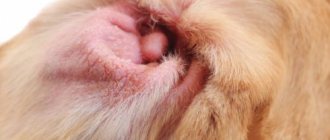Some “intimate” problems associated with digestion can affect not only humans. Pets suffer from them only slightly less often. For example, a dog has gas. This pathology causes many problems both for the pet itself and for its owners. Let’s say, it’s not easy to live in the same apartment with a dog who… every minute “spoils the air” and at the same time resembles an inflated balloon.
Flatulence, as a by-product of bacterial fermentation, often develops due to poor-quality feeding of the animal. Various dietary fibers, complex carbohydrates, overeating or a sudden change in diet are the main predisposing factors. Boxers, bulldogs, Boston terriers and some other brachycephalic breeds are also thought to be inherently predisposed. But not only pure flatulence can be the result of problems with feeding or digestion.
Aerophagia or flatulence?
Increased “secretion” of intestinal gases can cause not only flatulence, but also aerophagia . It is usually accompanied by a phenomenon also known as "borborygmy". Chronic stomach grumbling is not its only manifestation. It should not be assumed that all cases of borborygmi are accompanied by flatulence. Excess gases can cause a dog to constantly burp, but in this case they are still evacuated from the body, and therefore there are fewer prerequisites for flatulence. So many veterinarians are of the opinion that in these two cases, the “generation” of intestinal gases occurs for different reasons and leads to different consequences.
Borborygmi, in particular, can occur in dogs that eat food greedily and in large quantities . The faster they eat, the more air enters the digestive organs, and the higher the likelihood of developing belching and similar phenomena. But! If the animal cannot belch these gases back, which leads to the development of flatulence, it is imperative to find out what obstacle is causing this. It is possible that there is a tumor or other foreign body in the intestines or pylorus of the stomach that is preventing the normal passage of gases.
What breeds are most often susceptible to this problem?
All dogs can develop flatulence, especially when fed poor quality food. You may be confident that you are giving your pet the right food, but it turns out that it contains harmful fillers and artificial preservatives. Accidental waste from your table, too much fiber or allergenic foods can contribute to severe bloating.
But there are some breeds that are more prone to flatulence than others. An example would be the Basset Hound. This is a dog with digestive problems that requires special food and care.
Gastrointestinal diseases and flatulence
Certain medical conditions also increase the risk of flatulence. If there are any problems with the intestinal villi, for example, the absorption capacity of the mucous membrane sharply decreases, which leads to the effects of fermentation and even rotting of products found in the intestines.
Thus, boxers and French bulldogs are predisposed to histiocytic ulcerative colitis. In many cases it is caused by pathogenic strains of E. coli (treatment with conventional enrofloxacin is effective). Uncontrolled use of antibiotics also leads to bloating. They completely destroy all the beneficial intestinal microflora, which in dogs is responsible for digestion in the large intestine. The consequence is poor digestion of food, its remains begin to ferment and even rot. All this leads to massive release of intestinal gases. Gastritis, especially anacid gastritis, leads to a similar effect. When food in the stomach is not exposed to “full” gastric juice, it simply rots. The entry of such a “delicacy” into the intestines not only leads to bloating, but can also cause serious food poisoning. This is especially dangerous in the case of young animals and puppies.
Care
It's best to make a routine appointment with your veterinarian before attempting to eliminate your dog's gas yourself. Symptoms such as diarrhea and vomiting that occur along with flatulence may indicate gastrointestinal problems or other health problems. You can identify excessive gas during a visit to your veterinarian and see what they recommend.
Treatment of flatulence often involves changing your diet. General recommendations that will help your dog may include a highly digestible, low-fiber diet that doesn't contain too much meat. Special diets and medications may also be prescribed, depending on the veterinarian's diagnosis.
Proper diet
When a dog often passes gas, you need to try to normalize its diet. The problem is that without special knowledge in the field of nutrition, this can be very difficult to do. Digestive problems can be caused by just one or two components of a dog's diet, and identifying them is a priority for both the veterinarian and the pet owner.
To determine what exactly is the cause of bloating, you need to remember whether any new foods were included in the dog’s diet. As a rule, flatulence does not just appear “out of the blue” - there must be some kind of “trigger”. It is some new feed component. But everything is always so simple. Sometimes bloating develops against the background of a food allergy, the occurrence of which is impossible to predict.
For this reason, veterinarians recommend feeding dogs suffering from flatulence a diet moderately rich in dietary fiber. They normalize digestion and help improve peristalsis (that is, the intestines begin to contract normally). The latter, in turn, allows the dog to release the gases accumulated in its gastrointestinal tract.
In severe cases, special therapeutic diets may be prescribed. But! Their choice should be approached very biasedly. Many "medicated" foods may contain guar gum or modified starch, which promotes flatulence. In addition, a dog with a tendency to bloat should be limited in protein. It is this that is the main cause of smelly belching. The digestive system of a sick animal cannot normally process protein-rich food, which again leads to putrefaction and fermentation processes.
Diagnostics
Flatulence in dogs is rarely an independent disease. To determine the cause of increased gas formation, it is necessary to analyze the animal’s diet and feeding regimen. It is important to obtain data from general and biochemical blood tests, stool and urine tests, ultrasound examination of the abdominal organs, and x-rays of the abdominal organs. Sometimes gastroscopy and colonoscopy are necessary. Treatment of flatulence in a dog should be prescribed in accordance with the results of the examination. Only in this case will it be effective.
Probiotics
The main problem with bloating is the death of beneficial intestinal microflora, without which the dog will not have normal digestion in principle. The only way out is to repopulate the intestines with “positive” microbes . This can be done by giving your dog probiotics. The name of this group of drugs is made up of two words. “Pro” - which means “for”, and also “bios”, which means life. Simply put, these are medicines “for life”. More precisely, they contain colonies of beneficial symbiotic microorganisms. Even giving them to your pet once can significantly alleviate his condition with dysbacteriosis and severe bloating.
One note - probiotics should only be purchased in liquid form. Studies have shown that drugs produced in capsule form contain a maximum of 2-5% of living microorganisms.
The dog's stomach is rumbling
Rumbling or borborygmas are normally observed in dogs up to 1-2 times a day. At the same time, in large breeds, pathological forms of gastrointestinal disorders are more often noted due to the larger volume of the stomach and specific feeding, when owners prefer carbohydrates (porridge) to a meat diet. When you shouldn’t worry, and when you need to urgently consult a veterinarian – this is discussed later in the article.
Emergency help
Why can flatulence in a dog lead to its death? Here it is necessary to highlight such a concept as acute bloating, or acute flatulence. It develops rapidly, most often with liver pathology. Literally before our eyes, the belly increases in size, and if help is not provided urgently, the pet dies. It is difficult to provide assistance on your own, so try to get the animal to the veterinarian as quickly as possible.
If a dog has significant abdominal bloating and pain, the first action is usually GI decompression. The veterinarian may try to intubate the dog by passing a special tube through the mouth and down the esophagus. If this succeeds, the gas escapes through the tube. Unfortunately, the tube may not always reach the stomach. The veterinarian may then attempt to decompress the abdomen by inserting a needle. It is used to pierce the abdominal wall and the stomach itself. This allows gas to escape through the needle, making a hissing sound.
How to use
The active ingredient of this drug is simethicone. Its price is higher than most similar products, but there is no doubt about its effectiveness and safety. But despite this, you need to carefully observe the animal and, based on this, decide whether this medicine can be given. First of all, you need to understand whether the animal is experiencing pain and discomfort. If the dog is obviously worried, looking for a place to sit, often jumps up or, conversely, tries not to move, then you need to take measures to eliminate the painful symptoms:
- First you need to eliminate the causes of increased gas formation. Whether the dog has been in the trash or you just gave him something hard to digest is not that important. Adsorbents will help remove all excess, and in severe cases you need to rinse the stomach.
- After this, you can use Espumisan (simethicone). The price of one 30 ml bottle of drops is about 380 rubles. Capsules will cost approximately 270 rubles for 25 pieces.
- After this, irritation of the mucous membrane is relieved. For this purpose “Smecta” is used.
- And finally, you can populate the intestines with beneficial microflora. For this, both pharmaceutical preparations and natural yogurt are used.
Such an integrated approach to solving the problem is much more effective than the one-time use of one of the above drugs. But do not forget that bloating has its reasons. If this is a one-time occurrence, then nothing special needs to be done. But with regular flatulence, which is accompanied by pain, you should definitely consult a doctor.
One dose of the drug for a small animal is half a teaspoon or one capsule. The dosage in milliliters is calculated by the attending physician. The medicine should be given immediately after meals. The drug has a pleasant taste, but everything is individual, and your dog may not like it. Therefore, you can use a syringe without a needle, which will allow you to pour the medicine directly into the mouth.
Activated carbon
This is one of the most accessible, effective and inexpensive means that should always be on hand. Activated carbon is usually used for poisoning and flatulence. It is used for all mammals, that is, for both humans and animals. It is important to understand that this is a drug and should be used strictly in accordance with the doctor’s recommendations. In particular, take into account the weight of the animal.
If your dog is a small breed and his weight does not exceed 10 kg, you only need one tablet of activated carbon. For large animals, the dose is increased. The guideline is simple: for every 10 kg you give one tablet. How to give activated charcoal to a dog so that the effect is as quickly as possible? It is best to grind the medicine to a powder state and prepare a suspension. And it is convenient to insert it into the dog’s mouth using a regular syringe without a needle.
Activated carbon will quickly relieve pain and discomfort. Moreover, if flatulence is associated with poisoning, then the drug will absorb all the toxins and alleviate the condition. And we will continue to consider how to treat flatulence in a dog.











